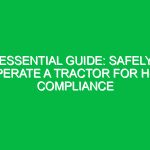Introduction
Operating a tractor is a vital skill in various industries, including agriculture, construction, and landscaping. However, it is crucial to understand how to operate a tractor safely and effectively, especially within the Health, Safety, and Environment (HSE) domain. This guide aims to provide a comprehensive overview of safe tractor Operation, emphasizing its relevance to HSE compliance. By following these guidelines, operators can minimize risks, enhance Safety, and promote environmental Sustainability.
Understanding the Importance of Safe Tractor Operation
Tractors are powerful machines that can perform a multitude of tasks, from tilling soil to hauling heavy loads. Despite their efficiency, they also pose significant Hazards. According to the Occupational Safety and Health Administration (OSHA), tractors are involved in approximately 75% of agricultural fatalities. Understanding how to operate a tractor safely is not just a matter of compliance; it is a critical component of Workplace Safety and health.
Key Components of Tractor Operation
To operate a tractor effectively, one must be familiar with its key components. Each part plays a role in ensuring safe and efficient operation:
- Engine: The heart of the tractor, it powers all operations.
- Transmission: Controls the speed and torque of the tractor.
- Brakes: Essential for stopping the tractor safely.
- Steering System: Allows the operator to maneuver the tractor.
- Hydraulics: Powers attachments and implements.
Understanding these components enables operators to make informed decisions while working and to recognize potential issues before they become serious Hazards.
Pre-Operation Checklist
Before starting a tractor, performing a thorough pre-operation inspection is essential. This checklist should include:
- Fluid Levels: Check engine oil, coolant, hydraulic fluid, and fuel levels.
- Tires: Inspect for proper inflation and any signs of wear or damage.
- Lights and Signals: Ensure all lights and signals are functioning correctly for visibility and communication.
- Safety Equipment: Verify that seat belts, roll-over protective structures (ROPS), and fire extinguishers are in place and operational.
By conducting these checks, operators can identify potential issues and mitigate risks before they affect performance or Safety.
Safe Operation Procedures
Knowing how to operate a tractor safely involves adhering to specific procedures. Here are key practices to ensure safe operation:
1. Training and Certification
All operators should receive proper Training and certification. This training should cover not only the mechanics of tractor operation but also safety protocols and emergency procedures. According to a study published in the Journal of Agricultural Safety and Health, adequate training can reduce the incidence of accidents significantly.
2. Wear Appropriate Personal Protective Equipment (PPE)
Operators should wear appropriate PPE, including:
- Hard hats
- Safety glasses
- Steel-toed boots
- High-visibility clothing
PPE helps protect operators from potential injuries while working.
3. Maintain a Safe Distance
When operating a tractor near other workers or equipment, maintaining a safe distance is essential. The operator should always be aware of their surroundings and ensure that bystanders are at a safe distance from the machinery.
4. Use Proper Hand Signals
When working with other personnel, clear communication is vital. Using standardized hand signals ensures that everyone is on the same page, especially in noisy environments where verbal communication may be challenging.
5. Avoid Overloading
Every tractor has a specified weight limit. Overloading can lead to loss of control and increased stopping distances, creating hazardous situations on the job site. Always adhere to the manufacturer’s recommendations regarding load capacities.
Identifying Hazards and Risks
Understanding potential hazards associated with tractor operation is essential for HSE compliance. Here are some common risks to be aware of:
- Rollovers: Tractors can easily tip over, especially when turning on slopes or uneven terrain. Operators should always use ROPS and seat belts to mitigate this risk.
- Entanglement: Loose clothing or hair can become caught in moving parts. Operators should secure long hair and avoid wearing loose clothing.
- Blind Spots: Tractors have significant blind spots. Operators should always check their surroundings before moving and use spotters when necessary.
- Exhaust Fumes: Prolonged exposure to tractor exhaust can be harmful. Ensure adequate ventilation when operating in enclosed spaces.
By being aware of these hazards, operators can take proactive measures to reduce risks.
Environmental Considerations
In addition to safety, tractor operators must also consider environmental impacts. Here are several practices that can promote environmental sustainability:
- Reduce Emissions: Regular Maintenance can help ensure that tractors run efficiently, reducing harmful emissions.
- Practice Soil Conservation: Use appropriate tillage techniques to minimize soil erosion.
- Use Integrated Pest Management: Implement pest control methods that reduce the dependency on chemical pesticides.
By adopting environmentally friendly practices, operators contribute to the sustainability of their operations and the surrounding ecosystem.
Regulations and Standards
Understanding the Regulations governing tractor operation is crucial for HSE compliance. In many regions, osha sets forth standards that operators must adhere to. Key regulations include:
- OSHA Standard 1910.178: This standard addresses the operation of powered industrial trucks, including tractors.
- OSHA Standard 1928: This regulation focuses on agricultural operations, outlining safety practices specific to tractor use.
Compliance with these regulations not only ensures legal adherence but also fosters a culture of safety within the workplace.
Real-Life Examples
To illustrate the importance of safe tractor operation, consider the case of a farmer who, due to a lack of training, lost control of a tractor while working on a hillside. The tractor rolled, resulting in serious injuries. This incident underscores the importance of proper training, awareness of hazards, and adherence to safe operation practices.
In contrast, a landscape contractor who implemented rigorous training and safety protocols reported a significant decrease in accidents and injuries on job sites. By prioritizing safety and compliance, this contractor not only protected their employees but also improved productivity and morale.
Conclusion
Safe tractor operation is a multifaceted responsibility that encompasses training, awareness, and adherence to regulations. By understanding how to operate a tractor within the HSE context, operators can significantly reduce risks associated with this powerful machinery. The importance of implementing safety practices, recognizing hazards, and adhering to legal requirements cannot be understated.
As we move forward, it is essential to foster a culture of safety and environmental awareness in all aspects of tractor operation. This commitment not only ensures compliance with HSE standards but also protects lives and promotes sustainability. Operators are encouraged to continually seek knowledge, remain vigilant, and prioritize safety in all tractor-related activities.


